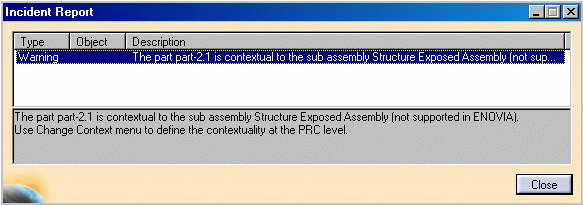![]()
Known Persistency Problems:
ENOVIA PRC exposes a subset of CATIA instances:
- only under a PRC,
- only for "exposed" references.
Safe Save Contextual Link Rules
First Rule: Exposed Context
If the persistency mode of the context and of the input instance is "exposed", you can create "exposed" contextual links. To do this, you need to check the option Use root context in assembly in Tools -> Options -> Infrastructure -> Part Infrastructure, which creates a contextual link at the PRC level. For more information about this setting, see "Customizing" in the Part Design User's Guide.
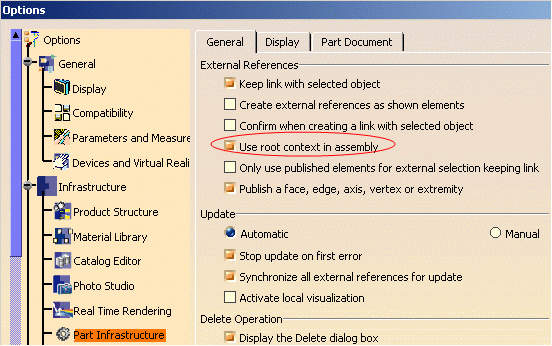 |
- If you create a link with a Publication defined on the root of a "workpackage", this Publication is exposed and you create an exposed contextual link at the PRC level.
- If you do not activate the option Use Root Context in
Assembly and create contextual links in a Structure Exposed
assembly, the following error message appears and link creation is not
allowed:

- If you create contextual links with new data or an existing component without complying with this rule, and if, to reroute these links properly, you save this assembly in LCA with Set PDM Properties, a warning appears during the save operation informing you that the contextual links are not saved / supported in LCA:
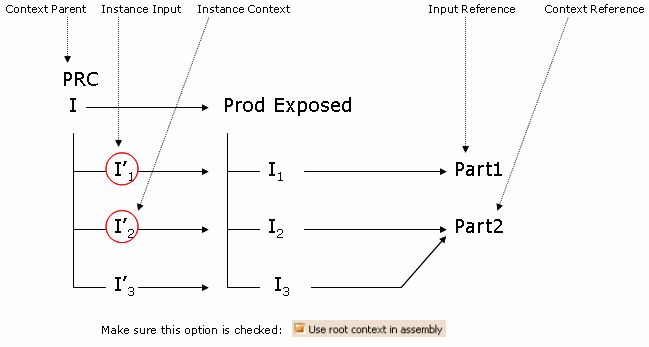 |
Second Rule: Workpackage Context
If the persistency mode of the context and input instance is "workpackage" and if they belong to the same Workpackage, you can create a "non-exposed" contextual link within a Workpackage. To do this, you need to uncheck the option Use Root Context in Assembly and create a contextual link at the Workpackage level and not at the PRC level. For more information about this setting, see "Customizing" in the Part Design User's Guide.
Note:
- If you activate the option Use Root Context in Assembly
and create contextual inks in a Workpackage assembly, the following error
message is displayed and link creation is not allowed:

- If you create contextual links with new data or an existing component
without complying with this rule, and if, to reroute these links
properly, you then save this assembly in LCA with Set PDM Properties,
a warning appears during the save operation informing you that the
contextual links are not saved / supported in LCA:
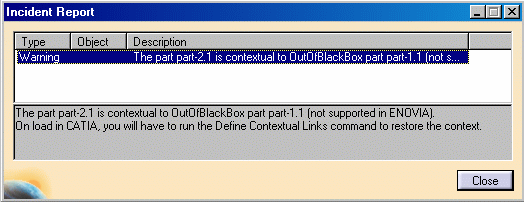
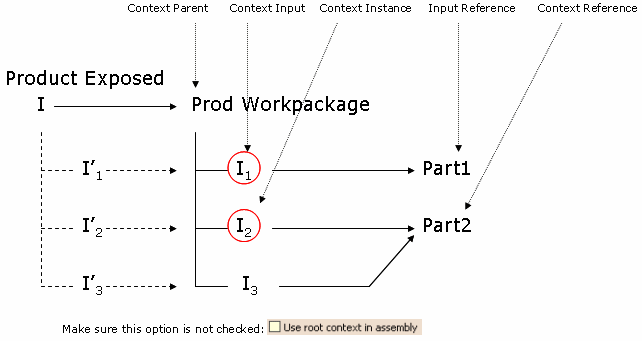 |
Both rules are also applied to the modification of contextual links. If the link does not correspond to the rules described above, a warning appears and edition is refused.
- In case you perform a New Evolution on a part in an
assembly, you have to be aware that a new part reference is created, but
that the associated document is not duplicated.
When a part reference has an associated document, the new part reference created via the New Evolution functionality is associated to the same document. This means that if the part contains contextual links that have been defined on instances, they remain the same even after performing a New Evolution on the part.
When the new part reference created via the New Evolution functionality is instantiated under the PRC, new instances are created. Therefore, the contextual links defined on the previous instances are broken when the assembly is loaded in CATIA V5. Rerouting the links on the new instances results in breaking them on the previous instances.
To reroute the contextual links properly:- in Enovia V5, go to the Document tab,
- right-click the instance and select New Reference to duplicate the document,
- in CATIA V5, load the new assembly,
- select Components>Define Contextual Links to reroute the contextual links on the new instances.
- For more information on contextual links, see also the Defining Contextual Links: Editing and Replacing Commands chapter.
- For more information on the New Evolution functionality, please refer to the Establishing a New Evolution chapter in the EnoviaLCA Engineering LifeCycle User's Guide.
- For more information on the New Reference functionality, please refer to the Creating a New Reference to a Document chapter in the EnoviaLCA Engineering LifeCycle User's Guide.
![]()
